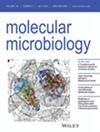Environmental Control of Queuosine Levels in Streptococcus mutanstRNAs
IF 2.6
2区 生物学
Q3 BIOCHEMISTRY & MOLECULAR BIOLOGY
引用次数: 0
Abstract
Queuosine (Q) is a modification of the wobble base in tRNAs that decode NA(C/U) codons. It is ubiquitous in bacteria, including many pathogens.变形链球菌strnas中排队苷水平的环境控制
Queuosine (Q)是trna中对NA(C/U)密码子进行解码的摆动碱基的修饰。它在细菌中无处不在,包括许多病原体。变形链球菌是牙菌斑生物膜的早期定植者,是龋病的重要参与者。利用遗传和生理方法的结合,预测的Q合成和回收途径在该生物体中得到验证。这些实验证实,变形链球菌可以通过与枯草芽孢杆菌和大肠杆菌相似的途径合成Q de novo。然而,与这些模式生物相比,变形链球菌具有独特的挽救途径,因为它使用属于能量偶联因子(ECF)家族的转运体,该转运体由preQ1依赖的核糖开关控制。此外,这种口腔病原体的Q水平很大程度上取决于培养基的组成,这表明微量营养素可以影响Q介导的翻译效率。
本文章由计算机程序翻译,如有差异,请以英文原文为准。
求助全文
约1分钟内获得全文
求助全文
来源期刊

Molecular Microbiology
生物-生化与分子生物学
CiteScore
7.20
自引率
5.60%
发文量
132
审稿时长
1.7 months
期刊介绍:
Molecular Microbiology, the leading primary journal in the microbial sciences, publishes molecular studies of Bacteria, Archaea, eukaryotic microorganisms, and their viruses.
Research papers should lead to a deeper understanding of the molecular principles underlying basic physiological processes or mechanisms. Appropriate topics include gene expression and regulation, pathogenicity and virulence, physiology and metabolism, synthesis of macromolecules (proteins, nucleic acids, lipids, polysaccharides, etc), cell biology and subcellular organization, membrane biogenesis and function, traffic and transport, cell-cell communication and signalling pathways, evolution and gene transfer. Articles focused on host responses (cellular or immunological) to pathogens or on microbial ecology should be directed to our sister journals Cellular Microbiology and Environmental Microbiology, respectively.
 求助内容:
求助内容: 应助结果提醒方式:
应助结果提醒方式:


